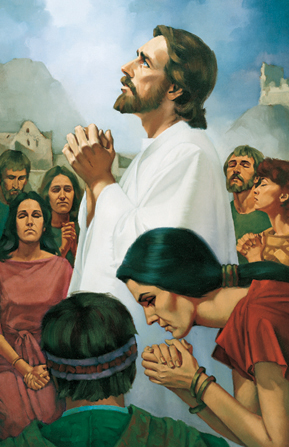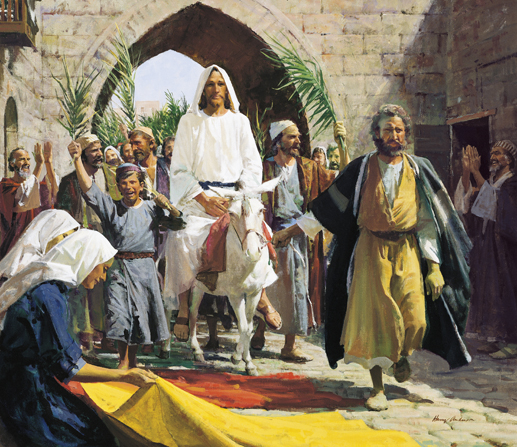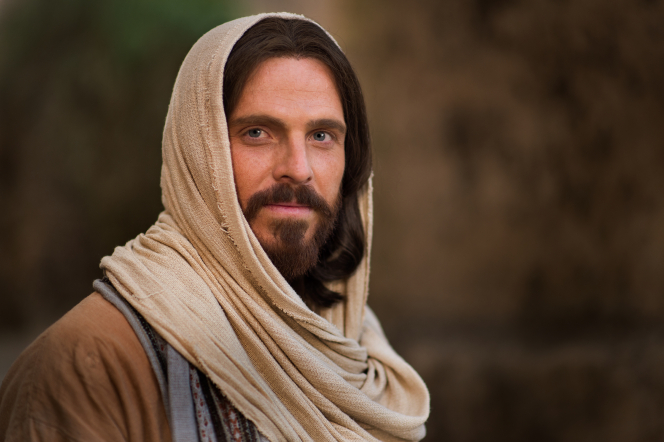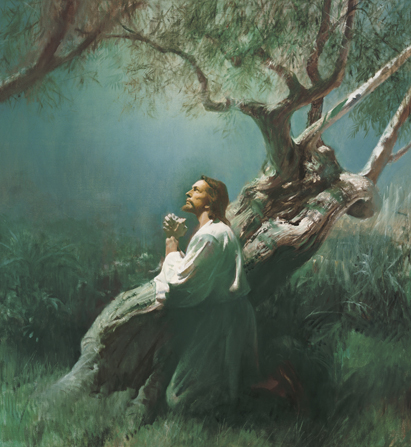Easter and Tax Day usually fall in the same month, at least in the United States. But this year the two have combined in a rather unique way for me and my family. Not only are they just days apart, but I am really feeling the burden of my taxes this year. This is a fitting juxtaposition for the peace that Easter brings. Jesus Christ said,
Come unto me, all ye that labour and are heavy laden, and I will give you rest.
Take my yoke upon you, and learn of me; for I am meek and lowly in heart: and ye shall find rest unto your souls.
For my yoke is easy, and my burden is light (Matthew 11:28-30).
Each one of us has burdens that seem heavy to bear. Burdens of sin, sorrow, disappointment, financial problems—or even taxes. And while the Savior won’t always eliminate the problems that we face in this world, He does offer us the peace that comes from following Him. The question is, then, how do we find Easter peace amid our April taxes—whatever that taxing burden may be? The answer is simple: By coming to truly know Jesus Christ.
Who is Jesus Christ?
Jesus Christ is the Savior and Redeemer of the world. He died on the cross and was Resurrected three days later. That is what we celebrate at Easter. But if we only focus on what the Savior did and not on who He is, we miss out. President Russell M. Nelson taught,
… We refer to His mission as the Atonement of Jesus Christ, which made resurrection a reality for all and made eternal life possible for those who repent of their sins and receive and keep essential ordinances and covenants.
It is doctrinally incomplete to speak of the Lord’s atoning sacrifice by shortcut phrases, such as “the Atonement” or “the enabling power of the Atonement” … or “being strengthened by the Atonement.” These expressions present a real risk of misdirecting faith by treating the event as if it had living existence and capabilities independent of our Heavenly Father and His Son, Jesus Christ.
Under the Father’s great eternal plan, it is the Savior who suffered. It is the Savior who broke the bands of death. It is the Savior who paid the price for our sins and transgressions and blots them out on condition of our repentance. It is the Savior who delivers us from physical and spiritual death.
There is no amorphous entity called “the Atonement” upon which we may call for succor, healing, forgiveness, or power. Jesus Christ is the source. Sacred terms such as Atonement and Resurrection describe what the Savior did, according to the Father’s plan, so that we may live with hope in this life and gain eternal life in the world to come. The Savior’s atoning sacrifice—the central act of all human history—is best understood and appreciated when we expressly and clearly connect it to Him.
So the question is, who is He?
His Role in God’s Plan
To better understand who Jesus Christ is, we need to understand His role in God’s plan for us. Elder Joseph B. Wirthlin taught,
We declare that Jesus is the Firstborn Son of our Heavenly Father in the spirit and the Only Begotten Son of God in mortality. He is a God, one of the three in the Godhead. He is the Savior and Redeemer of the world. In a premortal council at which we were all present, He accepted our Father’s great plan of happiness for His children and was chosen by the Father to give effect to that plan. He led the forces of good against those of Satan and his followers in a battle for the souls of men that began before this world was formed. That conflict continues today. We were all on the side of Jesus then. We are on the side of Jesus today. …
Under the direction of His Father, He created this world and many others. He came to this earth as the Son of God, the Eternal Father, and the mortal virgin Mary. He lived a sinless life.
Because of His unique and divine heritage, He was qualified for His role. President Russell M. Nelson explained,
Born of a mortal mother and an immortal Father, He was the only one who could voluntarily lay down His life and take it up again (see John 10:14–18).
With His sinless life, Jesus Christ set the example for us to follow. Through His Atonement, which included Resurrection, He provided the means whereby we can be forgiven of our sins and return to the presence of God if we are obedient to the commandments of God. The importance of His role cannot be overemphasized.
The Titles of Jesus Christ
We can learn much about the life and role of Jesus Christ through His titles. President Boyd K. Packer said,
He was known as Jehovah by the Old Testament prophets (see Abraham 1:16; Exodus 6:3). The prophets were shown of His coming: “Behold the Lamb of God, yea, even the Son of the Eternal Father!” (1 Nephi 11:21; see also John 1:14). His mother was told, “Call his name Jesus. … He shall be … called the Son of the Highest” (Luke 1:31–32).
Many titles and names are descriptive of His divine mission and ministry. He Himself taught: “I am the light and the life of the world. I am Alpha and Omega, the beginning and the end” (3 Nephi 9:18). “I am … your advocate with the Father” (Doctrine & Covenants 29:5; see also D&C 110:14). “I am the good shepherd” (John 10:11). “I am Messiah, the King of Zion, the Rock of Heaven” (Moses 7:53). “I am the bread of life: he that cometh to me shall never hunger [or] thirst” (John 6:35). “I am the true vine, and my Father is the husbandman” (John 15:1). “I am the resurrection, and the life” (John 11:25). “I am … the bright and morning star” (Revelation 22:16), “Jesus Christ, your Redeemer, the Great I Am” (Doctrine & Covenants 29:1).
He is the Mediator (see 1 Timothy 2:5), the Savior (see Luke 2:11), the Redeemer (see Doctrine & Covenants 18:47), the Head of the Church (see Ephesians 5:23), its Chief Cornerstone (see Ephesians 2:20). At the last day, “God shall judge … men by Jesus Christ according to [the] gospel” (Romans 2:16; see also Mormon 3:20).
The Garden of Gethsemane
Many of the Savior’s titles reflect His mission—which was to perform the Atonement. It is difficult to imagine the suffering required to make this sacrifice, which began in the Garden of Gethsemane. President Packer explained,
Before the Crucifixion and afterward, many men have willingly given their lives in selfless acts of heroism. But none faced what Christ endured. Upon Him was the burden of all human transgression, all human guilt. And hanging in the balance was the Atonement. Through His willing act, mercy and justice could be reconciled, eternal law sustained, and that mediation achieved without which mortal man could not be redeemed.
He by choice accepted the penalty in behalf of all mankind for the sum total of all wickedness and depravity; for brutality, immorality, perversion, and corruption; for addiction; for the killings and torture and terror—for all of it that ever had been or all that ever would be enacted upon this earth. In so choosing He faced the awesome power of the evil one, who was not confined to flesh nor subject to mortal pain. That was Gethsemane!
Elder Jeffrey R. Holland testified,
… He had power over death because He was divine but … He willingly subjected Himself to death for our sake because for a period of time He was also mortal. … In His willing submission to death He took upon Himself the sins of the world, paying an infinite price for every sorrow and sickness, every heartache and unhappiness from Adam to the end of the world. In doing so He conquered both the grave physically and hell spiritually and set the human family free.
The Atonement of Jesus Christ
Jesus Christ’s suffering in the Garden of Gethsemane was only part of His atoning sacrifice. Elder Holland taught,
Beginning in the spiritual anguish of the Garden of Gethsemane, moving to the Crucifixion on a cross at Calvary, and concluding on a beautiful Sunday morning inside a donated tomb, a sinless, pure, and holy man, the very Son of God Himself, did what no other deceased person had ever done nor ever could do. Under His own power, He rose from death, never to have His body separated from His spirit again. Of His own volition, He shed the burial linen with which He had been bound, carefully putting the burial napkin that had been placed over His face “in a place by itself,” the scripture says.
That first Easter sequence of Atonement and Resurrection constitutes the most consequential moment, the most generous gift, the most excruciating pain, and the most majestic manifestation of pure love ever to be demonstrated in the history of this world. Jesus Christ, the Only Begotten Son of God, suffered, died, and rose from death in order that He could, like lightning in a summer storm, grasp us as we fall, hold us with His might, and through our obedience to His commandments, lift us to eternal life.
President Packer said,
How the Atonement was wrought we do not know. No mortal watched as evil turned away and hid in shame before the Light of that pure being. All wickedness could not quench that Light. When what was done was done, the ransom had been paid. Both death and hell forsook their claim on all who would repent. Men at last were free. Then every soul who ever lived could choose to touch that Light and be redeemed.
The Redeemer
Having suffered in all that He did in performing the Atonement and then rising triumphant on the third day, Jesus Christ became the Redeemer of the world. Elder D. Todd Christofferson explained,
By His Atonement and Resurrection, Jesus Christ has overcome all aspects of the Fall. Physical death will be temporary, and even spiritual death has an end, in that all come back into the presence of God, at least temporarily, to be judged. We can have ultimate trust and confidence in His power to overcome all else and grant us everlasting life. …
In the words of Elder Neal A. Maxwell: “Christ’s victory over death ended the human predicament. Now there are only personal predicaments, and from these too we may be rescued by following the teachings of him who rescued us from general extinction.”
Having satisfied the demands of justice, Christ now steps into the place of justice; or we might say He is justice, just as He is love. Likewise, besides being a “perfect, just God,” He is a perfect, merciful God. Thus, the Savior makes all things right. No injustice in mortality is permanent, even death, for He restores life again. No injury, disability, betrayal, or abuse goes uncompensated in the end because of His ultimate justice and mercy.
Jesus Christ, in His infinite sacrifice, took the sting out of death. He took the senseless out of our suffering, and made it so that all things can work for our good if we will have faith in Him. And all of our physical infirmities will be taken from us when we are resurrected. And this He did not for personal gain or glory but because He loves us.
Our Mediator and Advocate
 Although His titles are descriptive, perhaps few seem as personal to me as the Mediator and Advocate with the Father. Because to be our Advocate, Jesus Christ needs to know who we are. And to be our Mediator, He must know us personally. President Nelson taught,
Although His titles are descriptive, perhaps few seem as personal to me as the Mediator and Advocate with the Father. Because to be our Advocate, Jesus Christ needs to know who we are. And to be our Mediator, He must know us personally. President Nelson taught,
Jesus is our Advocate with the Father (see 1 John 2:1; Doctrine & Covenants 29:5; Doctrine & Covenants 32:3; Doctrine & Covenants 45:3; Doctrine & Covenants 110:4). The word advocate comes from Latin roots meaning a “voice for” or “one who pleads for another.” …
This mission was clearly evident in the compassionate intercessory prayer of Jesus. In your mind, picture Him kneeling in fervent supplication. Listen to the beautiful language of His prayer. Sense His feeling for His weighty responsibility as mediator.
The great intercessory prayer, which is found in John 17:6-9, reads,
I have manifested thy name unto the men which thou gavest me out of the world: thine they were, and thou gavest them me; and they have kept thy word.
Now they have known that all things whatsoever thou hast given me are of thee.
For I have given unto them the words which thou gavest me; and they have received them, and have known surely that I came out from thee, and they have believed that thou didst send me.
I pray for them: I pray not for the world, but for them which thou hast given me; for they are thine.
Jesus Christ fulfilled the ends of the law through His infinite Atonement. He is our Advocate and Mediator because of this sacrifice. Through His suffering, He took upon Himself all of our infirmities, weaknesses and sins. Through our obedience to God’s commandments, we can repent of our sins and be cleansed through the Atonement of Jesus Christ.
The Love of God
Perhaps one of the greatest misconceptions of all time (or at least of mine) is that Jesus is our Mediator with God because God is angry and intimidating. This, however, is not the case. Elder Holland said,
Of the many magnificent purposes served in the life and ministry of the Lord Jesus Christ, one great aspect of that mission often goes uncelebrated. … It is the grand truth that in all that Jesus came to say and do, including and especially in His atoning suffering and sacrifice, He was showing us who and what God our Eternal Father is like, how completely devoted He is to His children in every age and nation. In word and in deed Jesus was trying to reveal and make personal to us the true nature of His Father, our Father in Heaven. …
So feeding the hungry, healing the sick, rebuking hypocrisy, pleading for faith—this was Christ showing us the way of the Father, He who is “merciful and gracious, slow to anger, long-suffering and full of goodness.” In His life and especially in His death, Christ was declaring, “This is God’s compassion I am showing you, as well as that of my own.” In the perfect Son’s manifestation of the perfect Father’s care, in Their mutual suffering and shared sorrow for the sins and heartaches of the rest of us, we see ultimate meaning in the declaration: “For God so loved the world, that he gave his only begotten Son, that whosoever believeth in him should not perish, but have everlasting life. For God sent not his Son into the world to condemn the world; but that the world through him might be saved.”
Thus, Jesus Christ is our Advocate to help us reunite with our loving Father, not to protect us from the wrath of God.
Easter Peace
Which brings us back to how we find Easter peace in the midst of our taxing burdens. This is the message of hope, love and peace that we find at Easter time. Jesus Christ paid the price for us so that, if we obey the commandments of God, we can escape the burdens of sin, sorrow, weakness and despair and find peace and rest in Him. That Jesus Christ not only suffered and died to save us from our sins—on conditions that He set—but that we will all live again. And that because He was resurrected, He took the sting out of death and claimed victory over the grave. That our taxing burdens of mortality will be taken from us in the Lord’s time and we will find His peace. And all of this was done because our Father in Heaven loves us so much that He sent His Only Begotten Son to show us the way back to Him. Speaking on an Easter day not many years ago, Elder Holland said,
So today we celebrate the gift of victory over every fall we have ever experienced, every sorrow we have ever known, every discouragement we have ever had, every fear we have ever faced—to say nothing of our resurrection from death and forgiveness for our sins. That victory is available to us because of events that transpired on a weekend precisely like this nearly two millennia ago in Jerusalem.
When we remember Jesus Christ and all that He did for us, we can find the Easter peace even in the midst of our April taxes.








